Yoga
Yoga For Weight Gain: 5 Easy Yoga Asanas
Published
1 year agoon
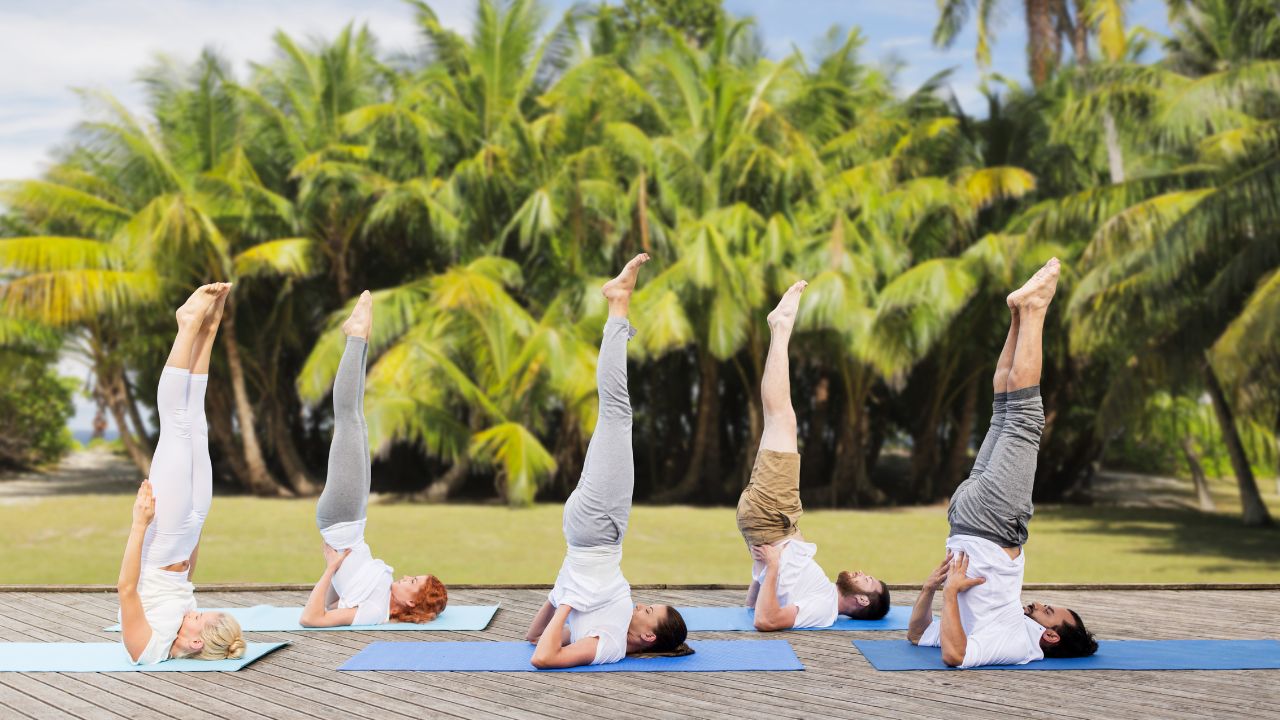
The increasing interest of people in yoga is because of the fact that it is believed to be effective in improving physical flexibility as well as assisting in stress management and body weight loss. Yoga has quite an impressive reputation considering it can help with weight gain, it is surprising to see not many openly support it.
Alternatively, some people consider and use yoga for weight gain as a structural way of increasing their body mass. It is interesting to note that yoga practices strengthen the structure and balance between physical and mental yoga.
Create a plan of weight gain wherein not only are you gaining weight but also taking care of your overall well-being and include certain asanas in your daily practice from this article so that your goals are achieved holistically.
With the help of these posed goals of body structures through yoga will be achieved beautifully. Let’s discuss these 6 easy yoga asanas that will fulfil your weight gain goals through yoga.
Simple Yoga for Gaining Weight
1. Bhujangasana (Cobra Pose)

Cobra Pose or Bhujangasana is an essential asana with strengthens the spine and increases the efficacy of the digestive system as some of its basic purposes. To perform this yoga, place yourself on the floor in a prone position, hands at the shoulder level. While inhaling the nose, raise your chest and arch your back with slightly bent elbows.
Maintain this position for around 20–30 seconds and then breathe out while relaxing. The particular yoga is beneficial for the stretching of abdominal muscles in a way that it helps in enhancing the appetite and increasing the rate of nutrient absorption into the body.
It exercises the back and helps to correct their positions which are fundamental to good physical health. Making use of Bhujangasana in your daily routine can be extremely beneficial during your process of gaining weight and enhancing your well-being.
2. Dhanurasana (Bow Pose)
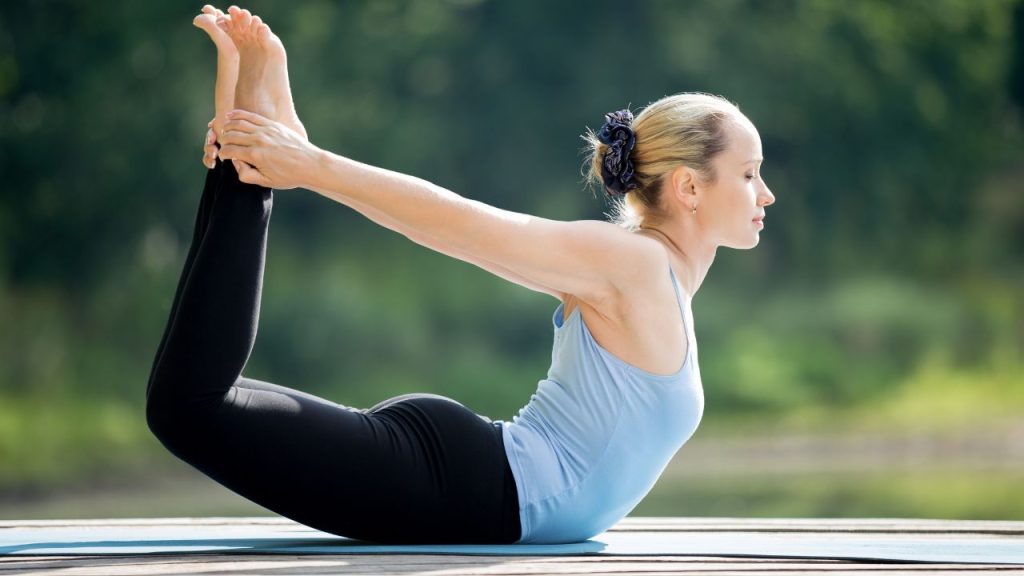
Dhanurasana, or the Bow Pose, is an energizing position that enhances the appetite. Start from a prone position with your knees bent and hands reaching backwards towards the ankles. During a deep inhalation, while holding the breath, lift the legs and chest forming a ‘bow’ shape.
Maintain this posture for about 20-30 seconds, then release the pose carefully. This asana facilitates consolidation of the abdominal muscles and enhances metabolism, as well as nutrient assimilation. This muscle engagement not only helps Dhanurasana in increasing muscle weight but also improves the range of motion.
This dynamic position, which can be employed as a restorative practice, can help in managing appropriate weight in a safe, cheaper and healthy way. Such balance is beneficial physically as well as psychologically.
3. Vajrasana (Diamond Pose)
Vajrasana, also known as the Diamond Pose, is commended for its ease in practice and is said to be an effective way to aid one’s digestion. To perform the pose: kneel, rest on the heels of your feet, and rest your forearms on your thighs. Maintain an upright position of your back while you focus on your breathing. Do a deep breath to the rhythm for about 5 to 10 minutes.
This particular pose improves gastrointestinal function by increasing the capacity of the intestine to absorb nutrients and decrease discomfort like bloating. Also, the practice of combined Vajrasana improves posture and develops lower body strength. Therefore, by adopting this simple but effective pose in your daily routine, you would help the body get its optimum weight.
4. Sarvangasana (Shoulder Stand Pose)
Also known as Shoulder Stand, Sarvangasana stands out as one of the full-body poses effective for core strengthening while also enhancing circulation. To perform this asana, start with lying on your back and then raise your legs while placing your hands on your waist.
Once your body is straight, remain in this position for between 30 seconds to 1 minute and gradually lower yourself. This inversion assists in increasing the blood supply to the stomach making it efficiently work and absorb nutrients better. Furthermore, it also helps in improving body muscles which in turn boosts power and equilibrium.
Additionally, individuals practising Sarvangasana regularly can focus more on putting on weight while also restoring energy which helps maintain good health and physical fitness.
5. Pavanamuktasana (Wind-Relieving Pose)
Pavanamuktasana or Wind-Relieving Pose, falls on the low end of the difficulty spectrum. It helps reduce bloating and aids in the digestion process. Lie down on your back with your head resting comfortably on a mat. Pull your knees towards your chest and hug them with both your arms. Now lift your head towards your knees while holding the position for 15-20 seconds.
Next, release your grip and relax. This yoga pose helps with gas and bloating as well as aids the body in better absorption of nutrients. This pose is quite easy which also makes it suitable for starters but has its perks in terms of helping the digestive system. When performed on its own or combined with other yoga asanas consistently, Pavanamuktasana can help you digest food more efficiently and improve the overall health of your body.
5. Savasana (Corpse Pose)
Savasana, known as the Corpse Pose in English, is the final resting pose practised towards the conclusion of the class to allow for a complete revitalisation of the body. For the succeeding day in this asana, come on your back, put both arms by your side and start to breathe deeply without any strain.
Remain in this asana for a period of between 5 to 10 minutes so that your body can thank you for the hard work. Savasana relieves tension in the nervous system, helps in controlling anxiety and promotes healing.
To the person concentrating on gaining weight, this technique allows the body to make the most out of the nutrients absorbed and guarantees proper tissue reconstruction, thus gaining weight is achievable when yoga is regularly practised.
Conclusion
Yoga for weight gain sounds interesting and unique. It needs time. According to a study, performing six specific poses regularly improved muscle growth, digestion, and overall health, making it easier to join a weight-gain program.
It must be emphasized that yoga alone is not enough; for success in weight gain goals, participants should also follow a balanced nutritional plan for maximum effectiveness time. It’s all about devotion and diligence.
Remember, practising yoga is more than just developing his body. It is a unique program of harmony of body and soul. The pain of discipline takes a back seat when one sees the enormous difference and improvement in physical and mental health.
You may like

Varicose veins are also referred to as swollen and bulging veins that are often visible on the surface of the skin. They can be distressing if ignored for a long time as they can cause pain, heaviness, and general discomfort. One of the methods which help in relieving the symptoms is yoga for varicose veins. It is a simple exercise with a meaningful purpose. It improves blood flow which is essential.
What’s important is that when you target such specific areas like certain poses that you do on a daily basis, it helps lower the venous pressure, boosts circulation and aids the body’s vascular health.
This article will present the wonders of yoga by taking you through 10 yoga poses focusing on varicose vein relief and prevention so that alongside your body, your mind can also relax and be at peace.
Precautions Before Practicing Yoga
Any injury or underlying health condition in yoga practice should be preceded with utmost caution. Such blocks and bolsters may ensure that certain exercises will be fully appreciated. Always pay attention to your body and the limits to which it can be pushed. If certain postures or movements are painful to the point of discomfort, do not continue.
A right start would be achieved by performing postures that are less intense and allow gradual and more relaxing movement in conjunction with deep inhalations. Those predisposed to or have a history of varicose veins or low blood pressure should relax whilst transitioning between poses to avoid dizziness or more severe complications.
Yoga Poses For Varicose Veins
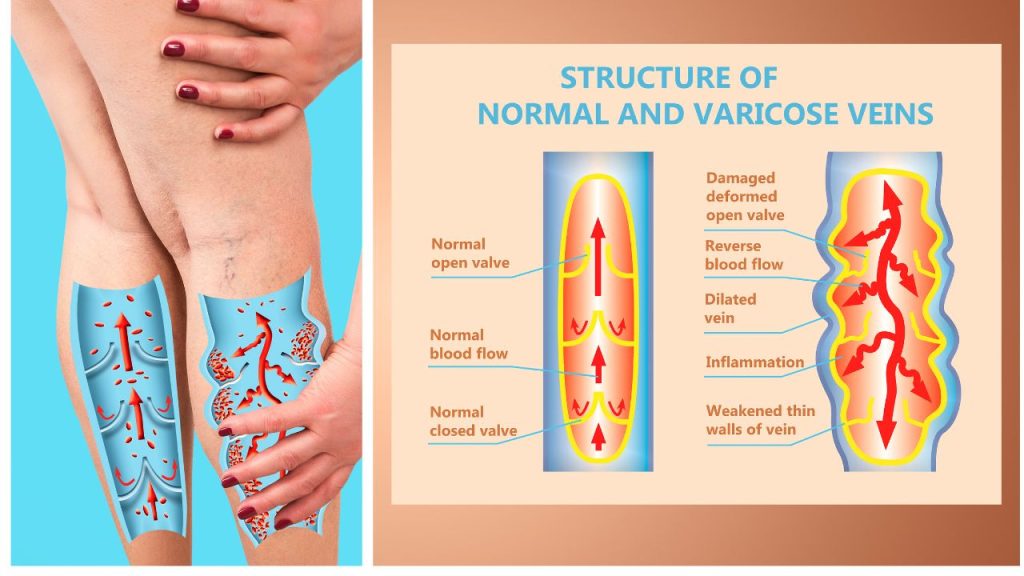
Yoga asanas for varicose veins are intended to increase the circulation of blood in the veins and relieve pain and swelling in the affected areas. Inverted postures withdraw circulation and pressure from the veins of the lower extremity and direct it toward the heart. Relaxed stretches alleviate tightness and help to build up alternate muscles which are necessary for the integrity of the veins.
These techniques, together with techniques for controlling the breath, provide a more comprehensive solution to the management of the symptoms. Regularly doing these targeted poses can also be helpful for people suffering from low blood pressure and other heart-related problems.
Each of the following poses has unique relations to various venous and circulatory disorders and their therapies, thus decreasing the chances of elevated blood pressure and exacerbation of chronic venous disorders.
1. Viparita Karani
Viparita Karani is probably one of the most powerful restorative poses for varicose veins and low blood pressure. First of all, based on your ability, lie flat on the ground and straighten the legs up against a wall. Try to pass a few minutes in this position while you perform deep breathing.
This pose slightly encourages the movement of blood downwards into the legs while blood pooling in the veins is also reduced thus relieving pressure in the veins. It also helps to relax the nervous system which may help in normalizing blood pressure. The Viparita Karani pose becomes a fundamental pose for those who wish to treat venous stasis and circulatory problems.
2. Tadasana
Tadasana or mountain position is one of those yoga practices that look very easy but it brings many benefits. Stand up straight with your feet closed and your arms resting by your sides, and distribute your weight evenly. Take a profound breath in as you raise your hands and push them to stretch pointing upwards raising your spine.
This position aids in invigorating muscles in the lower limbs and calves that are important for returning blood to the heart. Tadasana is also effective for those with low blood pressure as it aids in better posture and energy equilibrium. This practice will not only help in supporting vascular function but also help to enhance one’s awareness and attention which can be helpful to be incorporated for vascular control enhancing yoga routines.
3. Vajrasana
Vajrasana is important for nurturing a seated position that can assist and enhance blood circulation and digestion as well. Drop to a knee, and sit on the heel of your feet with your palms resting on your thighs. Ensure that you arch your spine straight and lean your chin slightly downwards. With your focus set on the torso, continue taking slow, rhythmic breaths.
This pose encourages blood flow to the lower extremities which helps relieve tired legs and enhances venous return. For those who have low blood pressure, this yoga technique is often useful in providing a sense of calmness and stability, thus improving their blood circulation.
4. Setu Bandhasana
Setu Bandhasana aka Setu Bandha Sarvangasana is one such yoga asana which bridges the gap between the mind body and spirit as the name suggests it helps in eliminating lower back pain by improving blood circulation.
To begin with, Get onto the floor and lie on your back with knees bent so that the feet are placed hip-width apart and arms are placed at the sides of the body. Then maintain mid-thoracic spine flexor strength, slowly move the pelvis in a caudal direction and begin to arch your lower back. This pose empowers the weak/underdeveloped heart by minimizing the blood supply provided to the upper half of the body. Setu helps such individuals to engage in a muscular contraction and relaxation which improves blood circulation throughout the body and enables optimal functioning of venous systems.
5. Sarvangasana
Minimal blood pressure and improper blood circulation have been of the major concerns for millions of people around the globe A Shoulder-stand Pose, Sarvangasana or Setu Bandha is a flagbearer when it comes to asanas promoting good venous health. Lay flat on the ground and bring your feet up straight while supporting the lower back with the hands so the arms are perpendicular to the body.
This even allows the proper name of the veins in the limbs which aids in the transportation of blood towards the heart thus relieving the venous blood from expansion If you have low blood pressure then oxygenation with the best oxygen mask plus calm moments may help. It is important to note that this pose is not a good idea for everyone, especially beginners and those with neck problems.
6. Pawanmuktasana
Pawanmuktasana, also known as Wind-Relieving Pose, is effective although is easy to practice. You should lie flat on the back and clasp one knee onto your chest with both hands. After a few breaths, switch your legs and repeat the same sequence for both legs.
This pose enhances the activity of the digestive organs, minimizes excess gas in the abdomen, and provides increased perfusion of the skin and muscles of the pelvic girdle. For those practising yoga for hypotension, this asana helps improve blood circulation comfortably. But it can be helpful for those who need to improve their venous status.
Pawanmuktasana manages to relieve stress in limbs and abdomens which effectively minimizes venous congestion and enhances blood circulation in the body. That is why this asana is commonly found in therapeutic yoga.
7. Uttanasana
Now for the Standing Forward Bend, the hamstrings will receive some blood flow thanks to the Uttanasana. Begin in a standing posture, bend from the hips to initiate a forward folding of the torso while extending your hands towards the floor. To prevent straining, knees should be kept slightly bent.
This pose, or asana, aids in mediating the return of venous blood from the legs to the heart thereby reducing swelling and pressure. For low blood pressure, it gently promotes blood circulation while calming the mind. With a consistent practice of Uttanasana, the overall flexibility of the body and vascular health improves. It is a very strong asana for alleviating stress and promoting the increase of blood flow which helps with the management of varicose veins and blood flow anomalies.
8. Navasana
The Boat Pose, or the Navasana focuses on strengthening the core while also promoting circulation. To begin performing this asana, sit on the ground and rest on your sitting bones while lifting the legs and torso to create a V-shape. Extend the arms forward to assist in balance during the pose.
This pose, or asana, when properly performed, not only strengthens the abdominal muscles but also supports venous health indirectly by improving overall circulation. For low blood pressure, it assists in boosting the heart and energizing the body. Though it can be difficult, with continuous engagement, Navasana helps to improve stamina for more blood circulation which makes it a necessary pose for any yoga practice focusing solely on the enhancement of the circulation system.
9. Pranayama
Pranayama assists in managing blood pressure, in adverse situations where high blood pressure is the result of stress, a substantiated theory of pranayama breathing such as Anulom Vilom (alternate nostril breathing) For low blood pressure, deep breathing exercises enhance oxygenation and blood delivery to circulation.
Control in breathing, while in poses for varicose veins would help overall circulation. In this regard, Pranayama is best done in a seated and quiet position, allowing concentration, relieving tension and mindfulness.
It may look simple, but because of its wide range of effects, it is considered very essential for therapeutic yoga. In addition, regular repetition helps in finding balance, pairing up well with the impact of physical poses on blood circulation.
10. Shavasana
Unlike the other poses, Shavasana is more passive which leaves the body feeling relaxed. To do the Shavasana position, lie flat on the ground with your arms lying by your sides making sure that your palms face up, and your legs slightly spread apart. Deep, even, and slow breath inhalations should be focused on.
As a stress & anxiety reliever, Shavasana induces great restorative relaxation. For yoga individuals who have trouble with high blood circulation, this particular pose works on the veins assisting in circulation. Although very passive, it aids in muscle recovery and alleviates mental pressure therefore performing this as the last pose is optimal.
Conclusion
It is rather tedious to even think about yoga as some form of exercise rather than simply a way to keep fit or maintain good health. Nevertheless, it is important to cite that doing so highlights the reason why people, especially women are prone to suffer from varicose veins. You might want to consider adding these ten inversions to your exercise routine as they are clearly indicated to maintain good blood flow around the veins.
On the other hand, Yoga for varicose veins aims to not only eliminate the physical effects but more so to promote mental relaxation which is of great significance in the overall body and health improvement. Furthermore, regular practice will allow for great results at all times, in order to help the person achieve a much more health-conscious and aware structure. It is now high time that the rejuvenation aspect of yoga is explored and emphasis is placed on how one should go about improving their varicose vein issues.
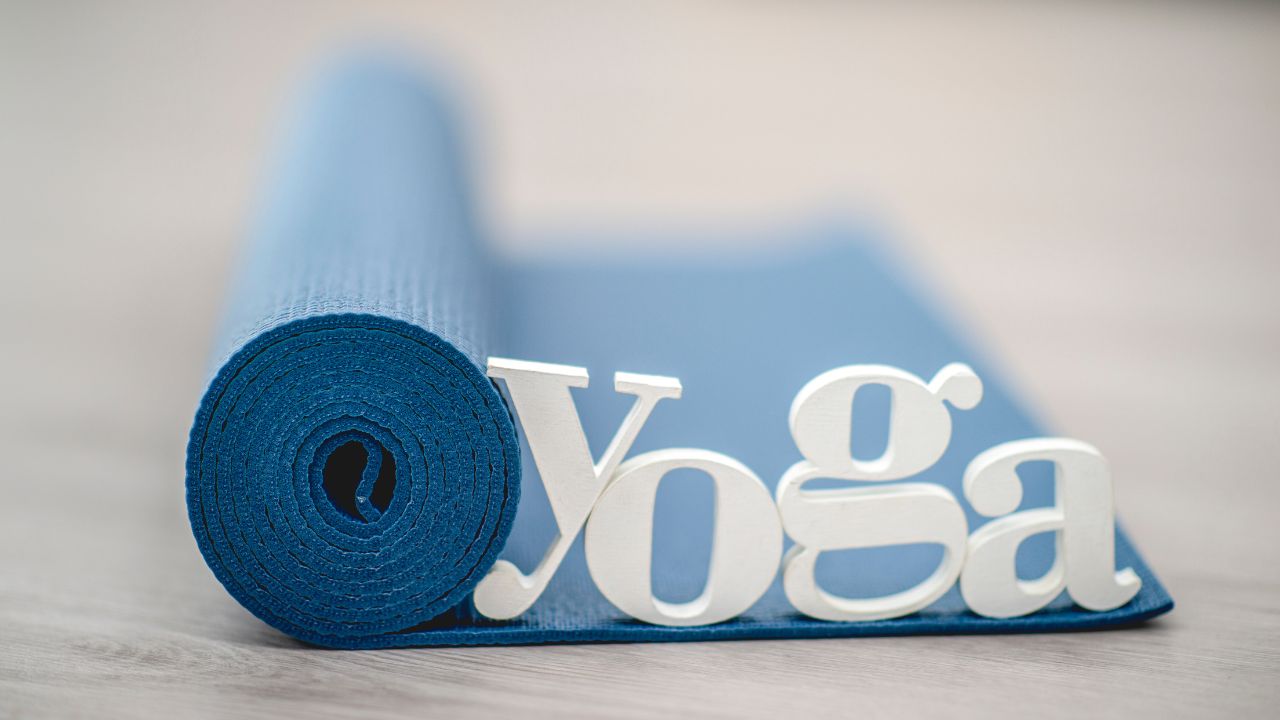
Hypotension or low blood pressure is a condition that can leave you sometimes light-headed and out of sorts. While it is true that pills and diet plans are critical factors in taking control of this problem, the involvement of yoga in your daily routine can be an effective and natural solution as well.
Yoga for low blood pressure helps in the improvement of blood flow, helping relax the mind and relieving stress while ensuring that the body achieves equilibrium in its functioning. Practising specific postures and using certain types of breath control, yoga helps maintain a state in the body which is conducive to proper circulation.
In this article, we focus on 6 effective and easy-to-perform yoga asanas meant to mitigate low blood pressure symptoms.
Overview of Low Blood Pressure (Hypotension)

Hypotension results from the level of blood flowing through arteries dropping below levels that are considered normal. It also causes several unpleasant symptoms such as dizziness or tiredness. The ability to survive with this condition varies from breaches with tolerance starting as low as 90/60 mm Hg or more.
Some of the causes may include reasons such as dehydration, heart failure, or simply being malnourished. As an enduring state, this form of low pressure is quite bad for day-to-day life. One of the ways to deal with managing the condition is through yoga for high blood pressure which is one of its root causes and is quite effective.
The Connection Between Yoga and Blood Pressure
The ancient practice of yoga has remarkable effects not only on physical health but also on mental health. Hypotonia management influences blood pressure due to the enhancement of circulation, calming the nervous system and stress reduction. The effects of yoga as a meditative exercise are to appraise the equilibrium of the body while improving blood circulation in the essential organs without overworking the heart.
The application of the two processes has the effects of loosening up and energizing the body while relaxing the mind for the purpose that blood pressure level is positively affected. Low blood pressure conditions can be worked on with the use of yoga which enhances low blood pressure symptoms and other living conditions.
Precautions Before Starting Yoga for Hypotension
While there are certain risks, considering blood pressure yoga remains a good option since there are a lot of advantages to overcoming those risks. Speaking to a healthcare provider is crucial, more so, if your case of hypotension is related to one more health issue. Try not to do movements or stances with extreme ranges of motion and deep inversion where one is upside-down, as this may lead to dizziness.
Turn off the television and make sure you have a water bottle readily available. Get out of bed and stand up gradually; there is no need to hurry. If you are suffering from low blood pressure, pay attention to how your body feels. In conclusion, if everything is done deliberately, blood pressure-related yoga can be a well-planned and pleasant approach to dealing with pressure problems.
6 Basic Yoga Exercises for Low Blood Pressure
1. Sukhasana
Sukhasana, or Easy Pose, is a sitting position where relaxation and breathing are performed mindfully. This Yoga Physiotherapy technique involves sitting with legs crossed, straightened spine and palms placed on the knees.
Along with promoting relaxation it also helps in calming the nerves, managing stress and improving blood flow. As a result, deep breaths taken up in this position bring more oxygen to the brain aiding in dizziness caused due to hypotension.
A perfect place to begin your asanas, performing this pose for 3-5 minutes will help you focus better throughout the rest of the session.
2. Balasana
Balasana or Child’s Pose is a gentle attaining from kneeling down position towards sitting back in between the curled-up thighs. During this child posture, the back bends and the torso rests the forehead on the ground achieving a restful position.
Extend the arms forward, resting them alongside the torso. With some close to feeling tired or having low blood pressure, this works wonders as with this pose the nervous system gets calmer and the body goes through better blood circulation. For restoration and calming of the body, this pose is perfect for anywhere between 2-3 minutes with deep breaths in the focus.
3. Viparita Karani
This is a restorative asana wherein the user lies on his/her back and places his/her legs on a vertical surface. This position improves one’s circulatory system by allowing gravity to assist in blood returning to the heart thereby reducing the effects of hypotension. It is also known to be very effective in reducing swelling of the leg due to prolonged sitting.
All that is needed is to hold the position for 5–7 minutes, breathe deeply and encourage the body to assume a relaxed state. Viparita Karani is ideal for situations where practitioners are feeling fatigued and wish to feel rejuvenated while also being practised, let’s say at the end of the day.
4. Tadasana
Tadasana is a standing asana which is also called Mountain Pose which can positively improve a person’s posture, his or her balance, and circulation. Keep your feet apart so that the width is. From inside both feet grounded evenly, the pelvis’s optimum place and the proportional centre between the two feet.
Tighten the core; lift the head with a straightened spine while stretching the arms upwards. This particular position facilitates the movement of blood further from the heart to the lower half of the body. The effects of Tadasana will be beneficial if performed for 2-3 minutes before commencing the physical activity as it will increase blood pressure, concentration levels and balance which are needed for vigorous and strong newly formed exercises for the rest of the day.
5. Adho Mukha Svanasana
Adho Mukha Svanasana is a restorative practice that lengthens the body and increases blood flow to the brain. Begin on all fours, tuck your toes under, and lift your hips upward to create an inverted V shape. Keep your arms straight and heels reaching toward the ground.
This pose strengthens the upper and lower body and enhances blood flow, lessening the numbness resulting from low blood pressure. Keep this asana for anywhere between 1-2 minutes while breathing deeply to feel invigorated and well-refreshed.
6. Shavasana
Shavasana or corpse pose is the final and the most beneficial relaxation pose which helps in utilizing the effects of yoga done earlier. Lying on your back with arms beside the body and feet a little less than shoulder-width apart. Shut your eyes and pay attention to your breathing pattern and the sound of your body as it tries to relax.
This asana increases the copa which helps to resist stress, calms the sympathetic system and keeps blood pressure in check. Do Shavasana for around 5-10 minutes to end your yoga session and don’t forget to use this all the time to feel rebalanced.
Conclusion
Yoga for low blood pressure offers a natural and effective solution to alleviate symptoms and enhance overall health. Asthakas, yoga’s gentle and restorative poses along with pranayama techniques help restore equilibrium within the circulatory system.
This ancient art attempts not only to treat the patients physically but also to improve one’s thoughts and aim for a better lifestyle. In order to manage hypotension, it is advisable to combine yoga practice with dietary changes creating an effective pathway for long-term health. Start practising yoga today and unleash the positive effects it has on your health and well-being.

The modern world faces an alarming increase in the prevalence of fatty liver disease that can be attributed to poor eating habits, inactive lifestyles, and high levels of stress. However, left alone, this condition which is characterized by excessive fat layer in liver cells has the potential of severely containing the capacities or the functions of the organ.
Amid increasing cases, however, the phrase ‘yoga for fatty liver’ has caught some attention as being a conventional way of improving the condition. Combining gentle movements with breath work or even mental focus, yoga works to help the liver, jump-start one’s metabolism and boost general health. By performing specific targeted postures regularly, people will be able to use what yoga has to offer to heal symptoms of fatty liver and lead a more balanced lifestyle.
Causes of Fatty Liver Disease
Fatty liver disease can be termed as the accumulation of fat within liver tissues often associated with obesity, excess sugar consumption or drinking a high volume of alcohol. As a result this condition which could start as accumulation may years down the line develop into more serious conditions like liver inflammation or liver scars.
Non-alcoholic fatty liver or NAFLD has recently become the most common type of liver disorder affecting some people across the globe. Changing the way one lives is crucial to treat this condition most effectively as it has been reported that the liver has self-healing properties which can be unlocked through healthy practices. Being a holistic form of treatment, yoga has also been effective. More importantly, Yoga helps improve the health of a person by curing the disease.
How Yoga Affects Liver Health
Through yoga, not only can the liver be strengthened, but the organs as well as the entire body can be improved and stress-free. Orally, internal detoxification is enhanced and self-induced by the practices as well. Specific postures or asanas especially focus on improving the blood supply to one’s liver by stimulating it.
Other concepts of yoga such as pranayama further assist in the recovery by infusing more oxygen into the body and cells thereby helping to reduce inflammation. Although other forms of training affect the liver as well, yoga for fatty liver caused a decrease in patients’ liver fat content and the team adjusted their liver enzymes.
Moreover, a severe psychological aspect comes into play, because yoga encourages awareness of oneself and one’s behaviour to prevent the severe development of fatty liver disease.
Preparations Before Practicing Yoga
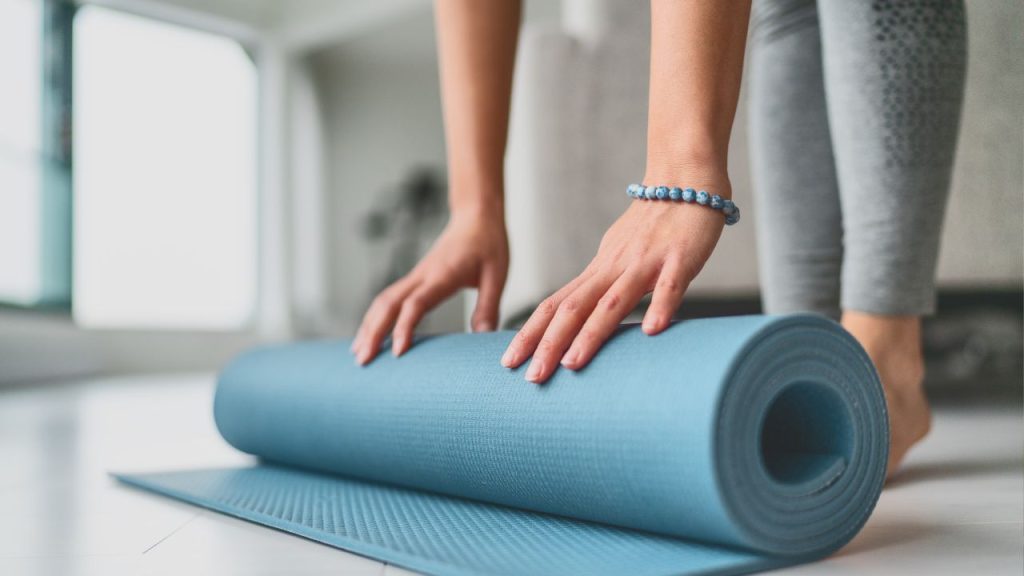
Before commencing a yoga session on fatty liver patients, certain steps should be taken. Ideally, it is better to practice yoga in the morning and when one’s stomach is empty so that the energy can be maximized.
Choose garments that are loose and easy to move with and try and find a calm and airy environment. Warm-up exercises help prevent injuries by preparing the body for the asanas. People who have health problems should seek the advice of a medical expert before doing yoga exercises.
A reasonable yoga schedule allows for progressive improvements in the liver, increased reduction in fat accretion and enhanced general health. Such simple preparations provide an ideal environment for ensuring the practice of effective and safe yoga classes.
7 Yoga Poses to Manage Fatty Liver
1. Bhujangasana (Cobra Pose)
In this pose, the practitioner first lies prone on the mat before raising the chest without moving the lower half of the body. This pose increases blood flow, stimulates digestive organs and helps the liver with detoxification.
2. Dhanurasana (Bow Pose)
In Dhanurasana, the practitioner brings the chest and thighs up while arching the body like a bow with grabbing the legs with the hands. This assists in reinforcing the abdomen, enhancing digestion, and protecting the liver organ.
3. Setu Bandhasana (Bridge Pose)
Setu Bandhasana entails raising the hips above the level of the pelvis in order to stimulate the abdominal organs and thereby enhance bile flow which is essential for liver detox.
4. Ardha Matsyendrasana (Half Sitting Twist)
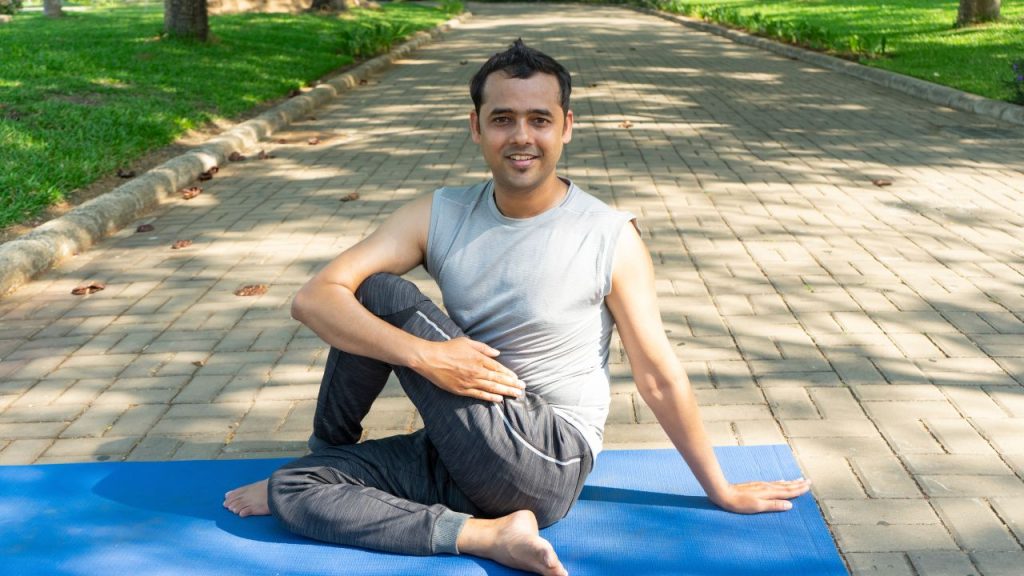
This twist or torsion-type yoga asana also compresses the liver and thus has the effect of allowing the liver to secrete higher bile to enhance the body’s detox functionality.
5. Kapalabhati Pranayama (Skull-Shining Breathing)
This technique brings a lot of oxygen into the liver, which in turn increases metabolism and assists in lipid degradation. Hence it is a good way to cleanse the liver.
6. Naukasana (Boat Pose)
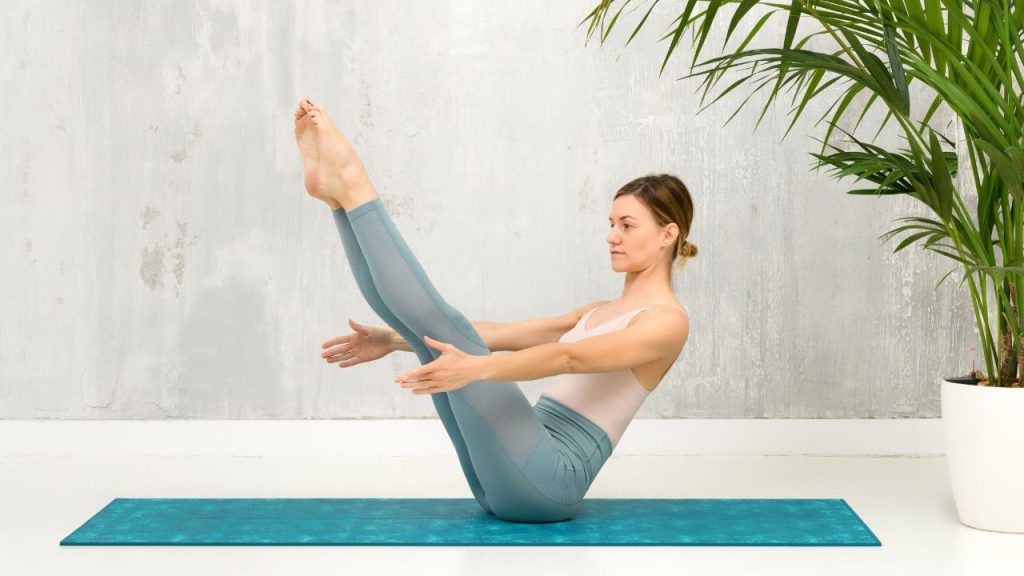
In Naukasana one balances on a person’s sit bones where abdominal muscles are utilized to free the abdomen of unwanted fats and also for the improvement of liver functions.
7. Anulom Vilom Pranayama (Alternate Nostril Breathing)
This method of practice is also very effective in calming the mind which in turn increases blood circulation and all functions of the liver.
Tips for Maximizing the Benefits of Yoga
If you want to make the best out of yoga for fatty liver, make sure you are regular in your practice. You should make yoga a part of your everyday practice and increase the duration and difficulty level over time.
Increase the effectiveness of yoga by combining it with powerful liver antioxidant-rich foods, greens and whole grains. Never skip warming up exercises for the asanas so that you do not exert the body and create chances for strain.
Similarly, practising yoga demands some level of mindfulness and concentration – try to control your breath to foster better mind and body unity. Also, it would be helpful if you drank enough water so that the body can remove toxins effectively. Practising yoga in conjunction with these habits is effective in resolving the symptoms of fatty liver and enhancing general health.
Common Mistakes to Avoid
When treating fatty liver with yoga, there are a few mistakes that one can commit that will slow down progress. One of the most common of them all is overexertion which results in pain and injury. Perform each stance in a manner that is appropriate to the individual’s levels, but most able to achieve when it comes to range of motion.
Another example is the absence of proper breathing which negatively impacts the Ayurvedic approach to practice. Similarly, completing the poses but not holding them for the suggested times will diminish their medical benefit. Not doing warm-up exercises may lead to muscle pulls and in turn injuries.
Lastly, complaining of lack of progress but at the same time practicing only occasionally, does help in any case. To avoid these mistakes one has to be aware and remember that the purpose of practicing regularly is for the benefit of the liver.
Conclusion
If there is a life-threatening condition then yoga for fatty liver can help you recover from any, not having had a single prior condition. This ancient form of exercise also helps cleanse and rejuvenate the liver and develop a mind-body connection at the same time.
Targeted asanas, stretching and incorporating focused breathing into your daily routine enhances quality of life. The combination of yoga practice with healthy food, water intake, and sensible behaviour makes yoga stronger.
It is time we take care of our liver – through yoga practice we can get rid of existing health problems and stop any from coming in the future. All it takes to be healthy is our commitment to a few small steps daily.
Latest
-

 Quotes and Captions1 year ago
Quotes and Captions1 year ago70+ Fake People Quotes in English
-

 Entertainment1 year ago
Entertainment1 year agoUpcoming Projects of Kate Beckinsale in 2024 and 2025
-

 Quotes and Captions1 year ago
Quotes and Captions1 year ago100+ Powerful Silence Quotes in English
-

 Friendship Advice1 year ago
Friendship Advice1 year ago9 Benefits of Social Media in Modern Friendships
-

 Entertainment1 year ago
Entertainment1 year agoList of Top 10 Most Subscribed Youtube Channels This Year
-

 Entertainment1 year ago
Entertainment1 year agoTop 10 Gaming Creators on YouTube in India
-

 Quotes and Captions1 year ago
Quotes and Captions1 year ago100+ Heart Touching Emotional Brother And Sister Quotes
-

 Entertainment1 year ago
Entertainment1 year agoWhat’s The Hype Around Samay Raina’s Show ‘India’s Got Latent’
